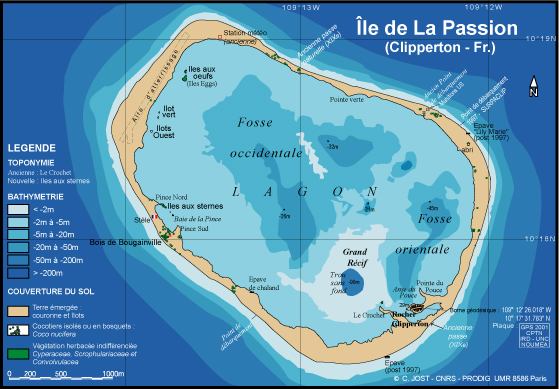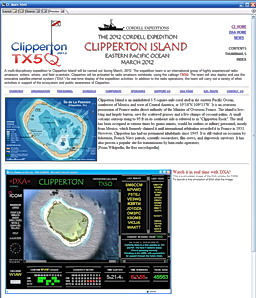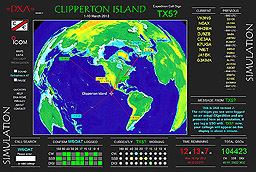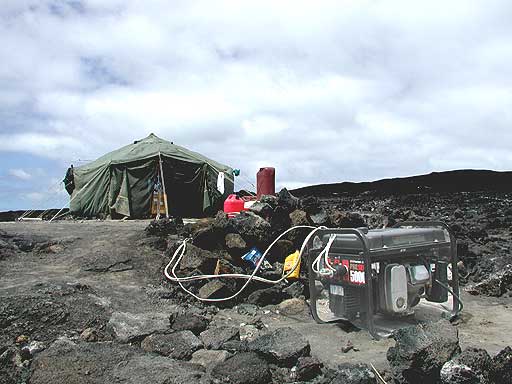We are pleased to announce a DXpedition to Clipperton Island, Territory of France in the Eastern Pacific, during March, 2013.
The project will be mainly an amateur radio DXpedition, but it will also involve selected scientific projects related to the environment, populations, and history of the island.
We invite your participation in the project, as a participant, collaborating scientist, student, or contributor.
The project will be mainly an amateur radio DXpedition, but it will also involve selected scientific projects related to the environment, populations, and history of the island.
We invite your participation in the project, as a participant, collaborating scientist, student, or contributor.
Clipperton Island is an uninhabited 3.5-square-mile coral atoll in the eastern Pacific Ocean, southwest of Mexico and west of Central America, at 10°18′N 109°13′W. It is an overseas possession of France under direct authority of the Minister of Overseas France. The island is low-lying and largely barren, save for scattered grasses and a few clumps of coconut palms. A small volcanic outcrop rising to 95 ft on its southeast side is referred to as "Clipperton Rock". The atoll has been occupied at various times by guano miners, would-be settlers or military personnel, mostly from Mexico, which formerly claimed it until international arbitration awarded it to France in 1931. However, Clipperton has had no permanent inhabitants since 1945. It is still visited on occasion by fishermen, French Navy patrols, scientific researchers, film crews, and shipwreck survivors. It has also proven a popular site for transmissions by ham radio operators. [From Wikipedia, the free encyclopedia]
Clipperton Island is an uninhabited 3.5-square-mile coral atoll in the eastern Pacific Ocean, southwest of Mexico and west of Central America, at 10°18′N 109°13′W. It is an overseas possession of France under direct authority of the Minister of Overseas France. The island is low-lying and largely barren, save for scattered grasses and a few clumps of coconut palms. A small volcanic outcrop rising to 95 ft on its southeast side is referred to as "Clipperton Rock". The atoll has been occupied at various times by guano miners, would-be settlers or military personnel, mostly from Mexico, which formerly claimed it until international arbitration awarded it to France in 1931. However, Clipperton has had no permanent inhabitants since 1945. It is still visited on occasion by fishermen, French Navy patrols, scientific researchers, film crews, and shipwreck survivors. It has also proven a popular site for transmissions by ham radio operators. [From Wikipedia, the free encyclopedia]
OVERVIEW
Cordell Expeditions is pleased to announce a new amateur-radio expedition to Clipperton Island, March, 2013. We will use the vessel Shogun from San Diego. This vessel was used for numerous previous trips to Clipperton, including TX5C in 2008. The goals of the project are: Conduct amateur radio operations to enable amateurs to make a contact with Clipperton; Implement an advanced version of the real-time online log website DXA; Carry out activites in support of the wildlife sanctuary and facilities on Clipperton Island. The first goal of the DXpedition is to enable as many contacts with Clipperton for as many different radio amateurs as possible. To this end we will field a highly experienced team of up to 24 operators and up to 8 active stations. The motivation for this is to participate in the worldwide activity of amateur radio, using it as a tool for fraternity and information. We expect to make as many as 100,000 contacts with 25,000 different stations during the expedition. We will favor making contacts with stations needing Clipperton for the first time, but all DXers are welcome to contact us. The callsign for the operation has not yet been selected. It is expected to use the prefix TX5. The second goal of the radio operation is to deploy and use DXA (version 2). Developed by KK6EK for the 2005 Kure Atoll DXpedition K7C, this system comprises a satellite link from the DXpedition site to a land-based server, and software to enable quasi-real-time communications between the DXpedition site and the server, including direct interaction with DXers. The system is described in various documents available at www.cordell.org/DXA and is available in a working simulated expedition mode on this website (click here). The purpose of DXA is to provide a nearly real-time presentation of the radio log as an aid to DXers wanting to make a contact with the DXpedition. The system reduces the need for duplicate (insurance) contacts, provides an engrossing view of the ongoing operation of the DXpedition, and enhances the integrity and accuracy of the log. The third goal is to contribute to ongoing research and monitoring of the environment at Clipperton. The team will carry out several scientific projects, including: (1) Search for possible infestation by the extreme pest ant Pheidole megacephala (the big-headed ant). A PDF of the proposal for this work can be obtained by clicking here. (2) Collection of representative specimens of marine algae for colleagues the Jepsen Herbarium, University of California, Berkeley. A PDF of the proposal for this work can be obtained by clicking here. The Clipperton Expedition is being managed by Cordell Expeditions, a nonprofit research group based in Walnut Creek, California. The group has fielded expeditions to remote sites for more than 25 years. Among other projects, Cordell Expeditions provided the scientific basis for designation of the Cordell Bank National Marine Sanctuary. The principal organizers of this project are: Dr. Robert W. Schmieder, KK6EK; Christian Janssen DL1MGB; and Carlos Nascimento NP4IW. It is policy of this project to observe and operate within all permits, regulations, and recommendations of the various agencies with interest in Clipperton Island, with particular attention to minimizing impact on the ecosystem. Safety and minimal impact to the Clipperton Island environment have priority in this operation. CORDELL EXPEDITIONS
QSL Manager  (Not the QSL card) (Not the QSL card)QSL manager for the 2013 Clipperton DXpedition will be announced later.
|







 An example of corporate use of project content for advertising is the following ad, which was published internationally by ICOM. The ad shows this organization's 2005 expedition to Kure Atoll, K7C. We will be happy to provide materials to enable you to generate advertising appropriate to your company.
An example of corporate use of project content for advertising is the following ad, which was published internationally by ICOM. The ad shows this organization's 2005 expedition to Kure Atoll, K7C. We will be happy to provide materials to enable you to generate advertising appropriate to your company.
No comments:
Post a Comment